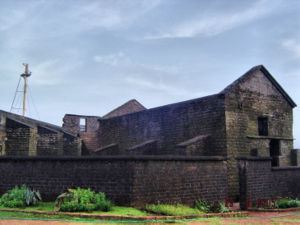Cannanore: Difference between revisions
d/w broken links |
|||
| Line 18: | Line 18: | ||
== History == | == History == | ||
[[Image:Kannur fort chapel.jpg|thumb|right|300px|The fort chapel, now ruins.]] | [[Image:Kannur fort chapel.jpg|thumb|right|300px|The fort chapel, now ruins.]] | ||
'''Cannanore''' was an early Portuguese settlement, Vasco de Gama landing there in 1498 on his way home from [[Calicut]] and a factory and colony following soon afterwards. In 1505, Francisco de Almeida (the first Portuguese Viceroy of India) founded St Angelo's Fort. In the 1660s the Dutch took control of Cannanore, but they relinquished power in the 1770s. In the following decade the British invaded the town when the Bibi captured 250 soldiers en route to the fight against [[Tipu Sultan]]. As the west coast headquarters Cannanore was a flourishing trade centre, third only on the west coast to [[Bombay]] and [[Karachi]], but when the HQ moved to the [[Nilgiris]] in 1887, its significance and prosperity waned. | '''Cannanore''' was an early Portuguese settlement, Vasco de Gama landing there in 1498 on his way home from [[Calicut]] and a factory and colony following soon afterwards. In 1505, Francisco de Almeida (the first Portuguese Viceroy of India) founded St Angelo's Fort. In the 1660s the Dutch took control of Cannanore, but they relinquished power in the 1770s. In the following decade the British invaded the town when the Bibi captured 250 soldiers en route to the fight against [[Tipu Sultan]]. As the west coast headquarters Cannanore was a flourishing trade centre, third only on the west coast to [[Bombay]] and [[Karachi]], but when the HQ moved to the [[Nilgiri Hills|Nilgiris]] in 1887, its significance and prosperity waned. | ||
==== Military ==== | ==== Military ==== | ||
| Line 51: | Line 51: | ||
:*[http://en.wikipedia.org/wiki/St._Angelo%27s_Fort St Angelo's Fort] | :*[http://en.wikipedia.org/wiki/St._Angelo%27s_Fort St Angelo's Fort] | ||
'''Other''' | '''Other''' | ||
:*[http://bmpix.org/bmpix/controller/index.htm Basel Mission Picture Archive]. Search for old photos of Cannanore taken by the Basel Mission Church | :*[http://bmpix.org/bmpix/controller/index.htm Basel Mission Picture Archive]. Search for old photos of Cannanore taken by the Basel Mission Church | ||
:*[http://malabardays.blogspot.com/search/label/Cannanore Malabar Days blog] Interesting posts about Cannanore churches, cemeteries and fort | :*[http://malabardays.blogspot.com/search/label/Cannanore Malabar Days blog] Interesting posts about Cannanore churches, cemeteries and fort | ||
Revision as of 11:13, 18 December 2013
| Cannanore | |
|---|---|
| [[Image:|250px| ]] | |
| Presidency: Madras | |
| Coordinates: | 11.855300°N 75.361615°E |
| Altitude: | |
| Present Day Details | |
| Place Name: | Kannur |
| State/Province: | Kerala |
| Country: | India |
| Transport links | |
| Madras Railway | |
Kannur is on the Malabar (west) coast, north of Tellicherry and south of Mangalore. It was the British military headquarters on the west coast until 1887.
Spelling Variants
Modern name: Kannur
Variants: Cannanore, Kananore
History

Cannanore was an early Portuguese settlement, Vasco de Gama landing there in 1498 on his way home from Calicut and a factory and colony following soon afterwards. In 1505, Francisco de Almeida (the first Portuguese Viceroy of India) founded St Angelo's Fort. In the 1660s the Dutch took control of Cannanore, but they relinquished power in the 1770s. In the following decade the British invaded the town when the Bibi captured 250 soldiers en route to the fight against Tipu Sultan. As the west coast headquarters Cannanore was a flourishing trade centre, third only on the west coast to Bombay and Karachi, but when the HQ moved to the Nilgiris in 1887, its significance and prosperity waned.
Military
Battle of Cannanore 1783
Surrender of Cannanore 1790
St Angelo's Fort
Built by the Portuguese in 1505, the triangular fort was captured by the Dutch in 1663 and held until 1771 when it was sold to the Ali Raja. The British seized it in 1790 and the fort subsequently became a central part of British military operations on the Malabar coast.
The fort is in the cantonment area of Cannanore. It is also known as Cannanore Fort.
Churches and missions

- St John's Church - Anglican
- Holy Trinity - Catholic
- Basel German Mission
Cemeteries
- Details of Malabar: Christian Memorials 1737-1990, by Dr John C. Roberts and N P Chekkutty, a book on European gravestones and church memorials in the Malabar towns of Cannanore (Kannur), Tellicherry (Thalassery) and Mahe which has details on the Portuguese, Dutch, French and English gravestones in the region. This India List thread gives details of the background to the book. More background may be read in In Search of European Graves in Malabar Chekkutty N.P’s Blog Chespeak August 16, 2013
- The book covers burials at the St Johns Anglican Church, the Holy Trinity RC Church and the German Basel Mission cemetery in Cannanore. The book also has details on the European regiments and native troops stationed at the Cannanore Cantonment and details on deaths in the armed forces.
Schools
- St Michael's Catholic Boys School - founded 1807
- St Theresa’s European Middle School - founded in 1867 by the Rev. Fr. Louis Mari Martelli then run then by the sisters of St. Joseph’s of the Apparition
Transport
Rail
Cannanore was an intermediate station on the Calicut to Mangalore section of the Madras Railway.
External links
Wikipedia
Other
- Basel Mission Picture Archive. Search for old photos of Cannanore taken by the Basel Mission Church
- Malabar Days blog Interesting posts about Cannanore churches, cemeteries and fort
Historical books online
- Cannanore Gazetteer 1857 Google Books
- Cannanore page 39, The Edinburgh Medical and Surgical Journal Volume 68 1847. Google Books. The cantonment was classified as one of the "Stations on the sea coast"
- "Cananor" page 150 A description of the coasts of East Africa and Malabar in the beginning of the sixteenth century by Duarte Barbosa, a Portuguese. Translated from an early Spanish manuscript in the Barcelona library; with notes and a preface by Henry E. J. Stanley. 1866 Archive.org